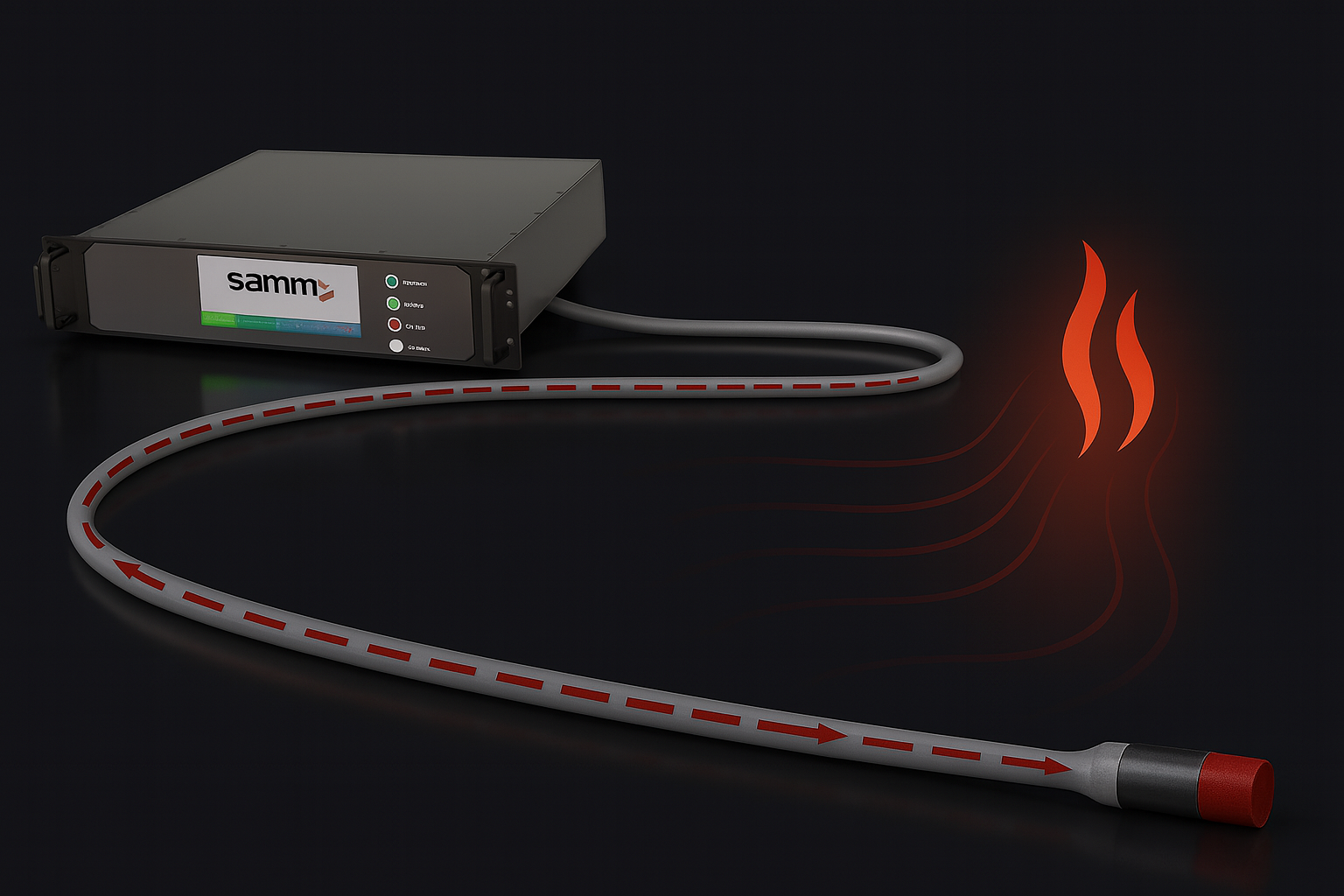FOTAS – Distributed Fiber Optic Early Warning for Critical Infrastructure
FOTAS – Distributed Fiber Optic Sensing for Proactive Infrastructure Security and Behavior-Based Early Warning
Introduction – Infrastructure Systems Capable of Generating Signals Before Risk Materializes
In critical infrastructures such as power transmission lines, tunnel cable galleries, solar energy fields, lithium-ion battery containers, and conveyor belt systems, the real requirement is not to receive an alarm after a fire or failure begins, but to detect the very first behavioral signal that indicates the approach of a risk. In many industrial scenarios, danger reveals itself not after the temperature threshold is exceeded, but through minor deviations in the thermal curve, abnormalities in acoustic signatures, or anomalies in pressure behavior. For this reason, fiber optic–based distributed sensing technologies offer a new engineering approach that surpasses the logic of traditional point-sensor systems.
Foundation of Fiber Optic Distributed Sensing: DTS, DTGS, and DAS
DTS – Distributed Temperature Sensing
Temperature is continuously measured along the fiber. The system evaluates every point of the cable as a virtual sensor, generating a seamless thermal map.
DTGS – Distributed Thermal Gradient Sensing (Behavior-Based Thermal Trend Analysis)
The temperature data provided by DTS is taken as a reference, while the thermal behavior curve and its rate of change are monitored. The system does not wait for a specific threshold; instead, it analyzes whether the rate of temperature change deviates from the natural pattern, producing an early anomaly signal before the threshold is even reached.
DAS – Distributed Acoustic Sensing
Micro-vibrations and pressure waves can be monitored along the fiber line. In this way, friction, gas leakage, mechanical loosening, or unauthorized interference can be detected even before any temperature increase occurs.
Technical Difference Between DTS and DTGS – Measuring Heat vs. Interpreting Thermal Behavior
As a laser pulse travels through the fiber, Raman scattering occurs. The returning signal contains temperature-sensitive spectral components. DTS processes this return signal to generate a spatial temperature distribution. DTGS goes a step further: It evaluates the time-based change of the curve, the speed of the temperature rise, and the direction of deviation, enabling an early warning logic capable of stating: “This region has begun to heat up, and the curve is departing from normal operation.”
FOTAS – A Locally Developed Fiber Optic Sensing Platform
By transforming optical sensing into a locally engineered, expandable platform, FOTAS establishes a strategic data layer in this field. DTS monitors temperature, DTGS evaluates thermal behavior, and DAS detects acoustic variations. FOTAS interprets these three signals directly in the field, converting them into actionable early-warning intelligence. Thus, FOTAS is not a single-device detector, but rather a family of distributed sensing technologies powered by an engineering-focused optical signal processing architecture.
Real-World Scenarios for Behavior-Based Early Warning with FOTAS
Thermal Runaway Behavior in Lithium-Ion Battery Systems
Before runaway occurs, micro thermal stress and pressure deviations emerge. While DTS monitors the temperature, DTGS captures the acceleration of the curve, and DAS detects the acoustic signature change that precedes the pressure release.
Localized Thermal Anomaly in GES DC Cables
In rooftop solar energy systems, loose connections or insulation fatigue distort the thermal distribution. DTS detects this change, and DTGS identifies the behavioral discontinuity, generating a maintenance call signal long before failure.
Friction-Induced Heating in Conveyor Belt Systems
Mechanical friction in conveyor belts produces thermal momentum before any significant temperature rise. DTGS perceives this as an abnormal behavioral shift, triggering a predictive alert.
Insulation Degradation in Power Transmission Lines
Insulation failure disrupts thermal behavior regularity before it causes measurable temperature increase. DTGS detects this deviation in form, providing a pre-failure signal even when values seem normal.
Leak Behavior in Petrochemical Pipelines
When a leak begins to form in chemical pipelines, local thermal equilibrium is disturbed, followed by changes in acoustic signature. When DTS + DTGS + DAS operate together, the system can detect a behavior-based risk signal well before a traditional alarm condition forms.
FOTAS Data Interpretation Capability
FOTAS can operate independently, but when necessary, it can integrate with SCADA, BMS, or maintenance systems, transforming early warning signals from simple detection outputs into decision-layer engineering intelligence. In this way, the system does not merely generate sensor data — it delivers interpreted engineering insight.
Conclusion – Fiber Infrastructures Are No Longer Just Carrying Data, They Are Reading Behavior
In today’s critical infrastructures, the true need is not just to generate alarms; it is to interpret the behavioral patterns of physical signals such as heat, pressure, friction, or acoustic vibration to detect risk before it materializes. Micro thermal stress in lithium-ion energy fields, connection fatigue in GES cables, insulation degradation in power lines, acoustic signal shifts before leaks in petrochemical pipelines, or friction trends in conveyor systems — all these scenarios point to a single shared truth: Risk begins in behavior. Temperature or pressure thresholds are merely the final stage. For this reason, FOTAS is not just a detector, but a locally engineered optical sensing platform that transforms the fiber line into a behavior-tracking engineering layer. DTS measures temperature, DTGS analyzes thermal gradients, and DAS interprets mechanical wave signatures. When these three signals are processed together, the fiber ceases to be just a data carrier; it becomes a continuous engineering sensor that monitors the heartbeat of the infrastructure. This marks the shift from systems that react after an event, to systems that read behavior before the event emerges. And this is not just early fire detection — it is the transformation of infrastructure into self-reporting optical intelligence networks.




